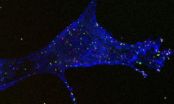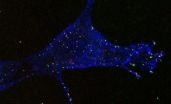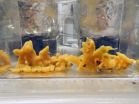(Press-News.org) WASHINGTON D.C. Feb. 17, 2014 -- Dengue fever, an infectious tropical disease caused by a mosquito-borne virus, afflicts millions of people each year, causing fever, headache, muscle and joint pains and a characteristic skin rash. In some people the disease progresses to a severe, often fatal, form known as dengue hemorrhagic fever. Despite its heavy toll, the prevention and clinical treatment of dengue infection has been a "dramatic failure in public health compared to other infectious diseases like HIV," said Ping Liu of the University of North Carolina at Chapel Hill.
Now, new research by Liu and her colleagues, to be presented at the 58th Annual Biophysical Society Meeting, which takes place in San Francisco from Feb. 15-19, could offer vital insight into the mechanism of dengue virus entry into cells -- and aid vaccine and clinical drug development.
Specifically, Liu, a postdoctoral scholar in the laboratories of cell biologist Ken Jacobson and biophysical chemist Nancy Thompson, along with dengue fever expert Aravinda de Silva, used high-resolution microscopes to examine the expression of a particular protein, known as DC-SIGN (for dendritic cell-specific intercellular adhesion molecule-grabbing nonintegrin), on the surface of immune system cells called dendritic cells.
VIDEO:
How dengue virus enters cells of our immune system: a 3D projection of a cell expressing on its surface DC-SIGN (stained in blue with antibodies) that have captured many dengue...
Click here for more information.
The normal role of DC-SIGN is to capture pathogens so that fragments of those pathogens can be presented as antigens on the surface of the dendritic cells. Such antigens then are recognized by T cells -- the workhorse cells of the immune system -- "which is one of the first steps in the normal immune response," Liu said.
While it has been known for some time that dengue used DC-SIGN to attach to cells, Liu and her colleagues used high-resolution microscopy to study exactly how the viruses used the protein to gain entry into cells. "DC-SIGN has a unique carbohydrate recognition domain on its extracellular portion, which binds to all sorts of carbohydrates on pathogens," she explained. (Other pathogens, including HIV and the bacterium that causes tuberculosis, are likely to use the same back door).
"An effective medication or vaccine should stop the process of dengue virus entry into cells," Liu said. To that end, she said, de Silva and his colleagues have identified strong neutralization antibodies that block dengue infection. "We are looking into the details of how those neutralization antibodies act and the role of DC-SIGN in the neutralization process."
By identifying the mechanism of antibody neutralization, Liu and colleagues hope to advance the development of vaccines for Dengue virus infections.
INFORMATION:
The presentation "Dengue Virus Infection Mediated by DC-SIGN" by Ping Liu, Marc R. Ridilla, Aravinda M. de Silva, Nancy L. Thompson and Ken Jacobson will be at noon on Monday, February 17, 2014 in Room 305 in San Francisco's Moscone Convention Center.
ABSTRACT: http://tinyurl.com/mj5j2nz
VIDEO:
This video shows red dengue viruses colocalized with (and captured by) DC-SIGN (green) and the two transported together into a cell.
Click here for more information.
ABOUT THE MEETING
Each year, the Biophysical Society Annual Meeting brings together more than 7,000 researchers working in the multidisciplinary fields representing biophysics. With more than 4,200 poster presentations, over 200 exhibits, and more than 20 symposia, the BPS Annual Meeting is the largest meeting of biophysicists in the world. Despite its size, the meeting retains its small-meeting flavor through its subgroup symposia, platform sessions, social activities, and committee programs.
The 58th Annual Meeting will be held at the Moscone Convention Center, 747 Howard Street, San Francisco, California.
PRESS REGISTRATION
The Biophysical Society invites professional journalists, freelance science writers and public information officers to attend its Annual Meeting free of charge. For press registration, contact Alisha Yocum at ayocum@biophysics.org or Jason Bardi at 240-535-4954.
QUICK LINKS
Main Meeting Page: http://tinyurl.com/mfjh37p
Program Highlights: http://tinyurl.com/mosxrof
Abstracts Search: http://tinyurl.com/lbrearu
ABOUT THE SOCIETY
The Biophysical Society, founded in 1958, is a professional, scientific Society established to encourage development and dissemination of knowledge in biophysics. The Society promotes growth in this expanding field through its annual meeting, monthly journal, and committee and outreach activities. Its 9000 members are located throughout the U.S. and the world, where they teach and conduct research in colleges, universities, laboratories, government agencies, and industry. For more information on the Society, or the 2014 Annual Meeting, visit http://www.biophysics.org
Mechanism of dengue virus entry into cells
Discovery by North Carolina researchers described at biophysical society meeting may advance development of vaccines to fight global, mosquito-borne scourge
2014-02-18
ELSE PRESS RELEASES FROM THIS DATE:
It's alive! Bacteria-filled liquid crystals could improve biosensing
2014-02-18
VIDEO:
Enabled by the birefringence of liquid crystal, motion of 24nm thick bacteria flagella now is easily visible using a simple polarizing microscope.
Click here for more information.
WASHINGTON D.C. Feb. 17, 2014 -- Plop living, swimming bacteria into a novel water-based, nontoxic liquid crystal and a new physics takes over. The dynamic interaction of the bacteria with the liquid crystal creates a novel form of soft matter: living liquid crystal.
The new type of active ...
Finding ways to detect and treat Alzheimer's disease
2014-02-18
WASHINGTON D.C. Feb. 17, 2014 -- Alzheimer's disease has long been marked by progress -- but not the kind of progress the medical community seeks. It is the most common form of dementia among older Americans, and its risk increases with increasing age; for those living with the disease, its ravages get worse over time; and as we move into the 21st century, it will place a greater and greater burden on society. The number of Americans living with Alzheimer's has doubled since 1980 and is expected to triple again by 2050.
Sadly, Alzheimer's disease has been the least prone ...
Annals of Internal Medicine tip sheet for Feb. 18, 2014
2014-02-18
1. Aortic valve replacement improves function but may not improve quality of life
Transcatheter aortic valve replacement (TAVR) improves functional status but may not improve overall quality of life, according to an article being published in Annals of Internal Medicine. Aortic stenosis (AS) is the most common valvular heart disease in developing countries and it affects up to 3 percent of adults older than 75. In recent years, TAVR has emerged as an alternative treatment to surgical aortic valve replacement (SAVR) for high-risk or inoperable patients with symptomatic ...
Stress hormones in traders may trigger 'risk aversion' and contribute to market crises
2014-02-18
High levels of the stress hormone cortisol may contribute to the risk aversion and 'irrational pessimism' found among bankers and fund managers during financial crises, according to a new study.
The study's authors say that risk takers in the financial world exhibit risk averse behaviour during periods of extreme market volatility – just when a crashing market most needs them to take risks – and that this change in their appetite for risk may be "physiologically-driven", specifically by the body's response to cortisol. They suggest that stress could be an "under-appreciated" ...
How well do football helmets protect players from concussions?
2014-02-18
PHILADELPHIA – A new study finds that football helmets currently used on the field may do little to protect against hits to the side of the head, or rotational force, an often dangerous source of brain injury and encephalopathy. The study released today will be presented at the American Academy of Neurology's 66th Annual Meeting in Philadelphia, April 26 to May 3, 2014.
"Protection against concussion and complications of brain injury is especially important for young players, including elementary and middle school, high school and college athletes, whose still-developing ...
How evolution shapes the geometries of life
2014-02-18
Why does a mouse's heart beat about the same number of times in its lifetime as an elephant's, although the mouse lives about a year, while an elephant sees 70 winters come and go? Why do small plants and animals mature faster than large ones? Why has nature chosen such radically different forms as the loose-limbed beauty of a flowering tree and the fearful symmetry of a tiger?
These questions have puzzled life scientists since ancient times. Now an interdisciplinary team of researchers from the University of Maryland and the University of Padua in Italy propose a thought-provoking ...
Theory on origin of animals challenged: Animals needs only extremely little oxygen
2014-02-18
One of science's strongest dogmas is that complex life on Earth could only evolve when oxygen levels in the atmosphere rose to close to modern levels. But now studies of a small sea sponge fished out of a Danish fjord shows that complex life does not need high levels of oxygen in order to live and grow.
The origin of complex life is one of science's greatest mysteries. How could the first small primitive cells evolve into the diversity of advanced life forms that exists on Earth today? The explanation in all textbooks is: Oxygen. Complex life evolved because the atmospheric ...
Researchers warn against abrupt stop to geoengineering method
2014-02-18
As a range of climate change mitigation scenarios are discussed, University of Washington researchers have found that the injection of sulfate particles into the atmosphere to reflect sunlight and curb the effects of global warming could pose a severe threat if not maintained indefinitely and supported by strict reductions in greenhouse gas (GHG) emissions.
The new study, published today, 18 February, in IOP Publishing's journal Environmental Research Letters, has highlighted the risks of large and spatially expansive temperature increases if solar radiation management ...
First biological marker for major depression could enable better diagnosis and treatment
2014-02-18
Teenage boys who show a combination of depressive symptoms and elevated levels of the 'stress hormone' cortisol are up to fourteen times more likely to develop major depression than those who show neither trait, according to research funded by the Wellcome Trust.
In a study published today in the Proceedings of the National Academy of Sciences, researchers from the University of Cambridge have identified the first biomarker – a biological signpost – for major, or clinical, depression. They argue that this could help identify those boys in particular at greatest risk ...
Why tackling appetite could hold the key to preventing childhood obesity
2014-02-18
A heartier appetite is linked to more rapid infant growth and to genetic predisposition to obesity, according to two papers published in JAMA Pediatrics today (Monday).
The studies investigated how weight gain is linked to two key aspects of appetite, namely lower satiety responsiveness (a reduced urge to eat in response to internal 'fullness' signals) and higher food responsiveness (an increased urge to eat in response to the sight or smell of nice food).
The first paper reveals that infants with a heartier appetite grew more rapidly up to age 15 months, potentially ...
LAST 30 PRESS RELEASES:
Transforming acoustic waves with a chip
When climate risk hits home, people listen: Study reveals key to engagement with disaster preparedness messaging
Major breakthrough against diabetes thanks to a microbial molecule that disarms inflammation
Silicon chips on the brain: Researchers announce a new generation of brain-computer interface
Getting rest is the best
Towards sustainable organic synthesis – Mechanochemistry replaces lithium with sodium in organic reactions
Wireless device ‘speaks’ to the brain with light
Greenhouse gases to intensify extreme flooding in the Central Himalayas
New study sheds light on Milky Way's mysterious chemical history
Could altering the daily timing of immunotherapy improve survival in people with cancer?
Weaving secondary battery electrodes with fibers and tying them like ropes for both durability and performance
Using social media may impair children’s attention
Science briefing: An update on GLP-1 drugs for obesity
Lower doses of immunotherapy for skin cancer give better results
Why didn’t the senior citizen cross the road? Slower crossings may help people with reduced mobility
ASH 2025: Study suggests that a virtual program focusing on diet and exercise can help reduce side effects of lymphoma treatment
A sound defense: Noisy pupae puff away potential predators
Azacitidine–venetoclax combination outperforms standard care in acute myeloid leukemia patients eligible for intensive chemotherapy
Adding epcoritamab to standard second-line therapy improves follicular lymphoma outcomes
New findings support a chemo-free approach for treating Ph+ ALL
Non-covalent btki pirtobrutinib shows promise as frontline therapy for CLL/SLL
University of Cincinnati experts present research at annual hematology event
ASH 2025: Antibody therapy eradicates traces of multiple myeloma in preliminary trial
ASH 2025: AI uncovers how DNA architecture failures trigger blood cancer
ASH 2025: New study shows that patients can safely receive stem cell transplants from mismatched, unrelated donors
Protective regimen allows successful stem cell transplant even without close genetic match between donor and recipient
Continuous and fixed-duration treatments result in similar outcomes for CLL
Measurable residual disease shows strong potential as an early indicator of survival in patients with acute myeloid leukemia
Chemotherapy and radiation are comparable as pre-transplant conditioning for patients with b-acute lymphoblastic leukemia who have no measurable residual disease
Roughly one-third of families with children being treated for leukemia struggle to pay living expenses
[Press-News.org] Mechanism of dengue virus entry into cellsDiscovery by North Carolina researchers described at biophysical society meeting may advance development of vaccines to fight global, mosquito-borne scourge






